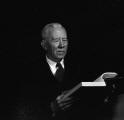|
John B. S. Norton
 John
Bitting Smith Norton was born in April 1872 to Samuel J. and Louisa
Norton of Cocke County, Tennessee. He relocated to Kansas in the late
1890s to attend the Kansas State Agricultural College at Manhattan, now
Kansas State University. John
Bitting Smith Norton was born in April 1872 to Samuel J. and Louisa
Norton of Cocke County, Tennessee. He relocated to Kansas in the late
1890s to attend the Kansas State Agricultural College at Manhattan, now
Kansas State University.
He received both his Bachelor of Science and
his Master of Science degrees from the Kansas State Agricultural College
(KSAC) in 1896 and 1901, respectively. While he was in school, he
worked as an assistant professor at the Agricultural Experiment Station
of the KSAC from 1894 to 1896 and as a botanical assistant at the
Missouri Botanical Garden in St. Louis, Missouri, from 1896 to 1901.[6]
J. B. S. Norton then moved to Maryland,
where he was appointed State Plant Pathologist as well as professor of
botany and plant pathology at the Maryland Agricultural College and was
a founder of the college's herbarium.[4]
As State Plant Pathologist, he was responsible for experimentation,
botanical surveying, gathering and disseminating information, and
instruction. He also shared responsibility with the State Entomologist
for nursery and orchard inspections.
 In 1912, Dr. J. B. S. Norton of the
Maryland Agricultural Experimental Station began selecting tomato plants
for disease resistance. In 1915, he sent several unnamed resistant
selections to tomato growers and breeders. Included in the list was
Fred J. Pritchard of the USDA who started his
own disease-resistance work that year. After further selection work, he
released the 'Norton'
tomato in 1917. It became one of the leading disease resistant tomato
varieties, especially in the Eastern tomato growing regions, for some
years.[2,3] In 1912, Dr. J. B. S. Norton of the
Maryland Agricultural Experimental Station began selecting tomato plants
for disease resistance. In 1915, he sent several unnamed resistant
selections to tomato growers and breeders. Included in the list was
Fred J. Pritchard of the USDA who started his
own disease-resistance work that year. After further selection work, he
released the 'Norton'
tomato in 1917. It became one of the leading disease resistant tomato
varieties, especially in the Eastern tomato growing regions, for some
years.[2,3]
Norton gave up his position as State Plant
Pathologist in 1914 to devote all of his time to his teaching and other
duties at the Experiment Station, a unit of the Maryland Agricultural
College.
Norton was also a prolific writer who
contributed articles to magazines, bulletins, newsletters, newspapers,
and Bailey's Cyclopedia of American Horticulture. During his tenure at
the Maryland Agricultural College (1901-1942), he belonged to many
horticultural societies and served as secretary-treasurer of the
Maryland Horticultural Society.
The University of Maryland granted Norton
an honorary Doctor of Science in 1923. He retired from teaching on April
1, 1942, at the age of seventy and held the title of professor emeritus
until his death.
After his retirement, Norton grew dahlias
for sale and show at his Hyattsville home under the name Norton Gardens.
He belonged to the First Baptist Church of Hyattsville and Mount Vernon
Lodge No. 179 of the Masons. J. B. S. Norton died on July 10, 1966, in
Prince George's County, Maryland, at the age of ninety-four.[1]
References:
-
J. B. S. Norton Papers at the University of Maryland - Article
and republished, for educational purposes, under the fair use clause
of the 1976 copyright act. Text and images carry the copyright of
their respective authors, photographers, and publishers. This page may
be freely linked but not duplicated in any fashion without prior
written permission of the respective copyright holders.
-
"Yearbook
of Agriculture," USDA, 1937.
-
"Development
of Wilt-Resistant Tomatoes," by Fred J.
Pritchard, USDA, Bulletin No. 1015, March 28, 1922.
-
Norton-Brown Herbarium, University of Maryland -
Image copyright University of
Maryland; Botany Department photographs; Special Collections,
University of Maryland Libraries. Republished here for educational
purposes, under the fair use clause of the 1976 copyright act.
-
Image
of J.B.S. Norton circa 1916, Library of Congress, Call Number
LC-B5-55974A [P&P]
-
"A
Guide to the Archives and Manuscripts of the Missouri Botanical Garden,"
by Martha Riley, St. Louis, MO, 1995
 |